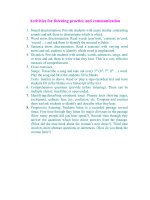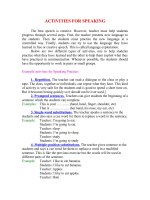- Trang chủ >>
- Đề thi >>
- THPT Quốc Gia
s1005 activities
Bạn đang xem bản rút gọn của tài liệu. Xem và tải ngay bản đầy đủ của tài liệu tại đây (175.7 KB, 2 trang )
ACTIVITY SHEET
EPISODE 5: GLOBAL WARMING
ACTIVITY 1
Practise identifying referents and the noun phrases to which they refer in the
following paragraph about sharks.
The shark is a carnivorous (meat-eating) sea mammal. It is one of the most feared
fish in the ocean, having the reputation of attacking humans. There are many species
that roam the great oceans of the world. They vary in size and habit. Though the
whale shark is considered the largest, it is relatively harmless, and mainly eats small
fish and plankton. Other sharks include the hammerhead, mako and bull. These are
fast, powerful sea animals that feed on larger fish such as mackerel, tuna and
herring. The white shark, on the other hand, is the most frightening and dangerous.
It gets this reputation because of its size and keen sense, which enables it to prey
successfully. Since the early 1960’s, scientists have been studying sharks because
of their potential to provide the medical world with defences against diseases such as
cancer and arthritis. That would be welcomed by all.
ACTIVITY 2
Read the passage on planets. Choose the correct referent and identify to which
noun phrase the pronoun refers. Check your punctuation.
A planet is a large, round object that travels around the sun. There are nine planets,
which together comprise a part of the solar system. (1. this, these, that) include
Mercury, Venus, Earth*, Mars, Jupiter, Saturn, Uranus, Neptune and Pluto.
Much like stars in appearance, planets differ from (2. they, them, their) in that (3. they,
them, their) shine steadily, while stars twinkle. (4. this, these, those) may be the result
of the light and heat that stars produce on (5. its, they, their) own, (6. this, these, that)
which the planets emit is reflected light from the sun.
Though the planets differ substantially in size and vary widely in terms of (7. their, its,
they) surface conditions, (8. them, they, these) are similar insofar as orbital
movement is concerned. All of (9. them, they, these) move in a westward direction
across the sky.
Astronomers have been fascinated by planets for thousands of years, but more
recently have become interested in the feasibility of sustainable life on planets.
Answers to (10. these, that, they) may give scientists an insight into our long-term
future.
*Tip: Earth should always be capitalised.
Page 1 of 2
ACTIVITY 1: Answers
The shark is a carnivorous (meat-eating) sea mammal. (1) It [the shark] is one of the
most feared fish in the ocean, having the reputation of attacking humans. There are
many species that roam the great oceans of the world. (2) They [many species]
vary in size and habit. Though the whale shark is considered the largest, (3) it [the
whale shark] is relatively harmless, and mainly eats small fish and plankton. Other
sharks include the hammerhead, mako and bull. (4) These [hammerhead, mako
and bull (other sharks)] are fast, powerful sea animals that feed on larger fish such
as mackerel, tuna and herring. The white shark, on the other hand, is the most
frightening and dangerous. (5) It [the white shark] gets (6) this [the most
frightening and dangerous] reputation because of (7) its [the white shark’s] size
and keen sense, which enables (8) it [the white shark] to prey successfully. Since
the early 1960’s, scientists have been studying sharks because of (9) their [sharks’]
potential to provide the medical world with defences against diseases such as cancer
and arthritis. (10) That [defences against diseases] would be welcomed by all.
ACTIVITY 2: Answers
A planet is a large, round object that travels around the sun. There are nine planets,
which together comprise a part of the solar system. (1) These [planets] include
Mercury, Venus, Earth, Mars, Jupiter, Saturn, Uranus, Neptune and Pluto. Much like
stars in appearance, planets differ from (2) them [stars] in that (3) they [planets]
shine steadily, while stars twinkle. (4) This [planets shine steadily and stars
twinkle] may be the result of the light and heat that stars produce on (5) their
[stars’] own, whereas (6) that [light and heat] which the planets emit is reflected
light from the sun. Though the planets differ substantially in size and vary widely in
terms of (7) their [planets] surface conditions, (8) they [planets] are similar insofar
as orbital movement is concerned. All of (9) them [planets] move in a westward
direction across the sky. Astronomers have been fascinated by planets for thousands
of years, but more recently have become interested in the feasibility of sustainable
life on planets. Answers to (10) that [feasibility of sustainable life] may give
scientists an insight into our long-term future.
Page 2 of 2









